The guitar bridge does indeed affect tuning. The bridge of a guitar is responsible for anchoring the strings and transmitting their vibrations to the instrument’s body. It plays a crucial role in maintaining the tension and pitch of the strings. A poorly designed or improperly set up bridge can result in tuning issues.
There are several factors that can contribute to tuning problems caused by the guitar bridge. One common issue is the bridge not being properly secured to the guitar body. This can cause the bridge to shift or move during playing, leading to changes in string tension and ultimately affecting the tuning stability.
Another factor is the saddle height and intonation. The saddle is the part of the bridge that the strings rest on. If the saddle height is too high or too low, it can cause the strings to have incorrect tension, leading to tuning problems. Additionally, the intonation refers to the accuracy of the guitar’s notes across the fretboard. If the intonation is off, it can cause certain strings or frets to be out of tune.
The material of the bridge can also have an impact on tuning stability. Different materials have different densities and can transmit vibrations differently. For example, a bridge made of softer material may absorb more string vibrations and result in a muffled or dull tone, affecting the overall tuning perception.
In my own experience, I have encountered tuning issues that were directly related to the guitar bridge. One time, I noticed that my guitar’s high E string would frequently go slightly sharp after only a few minutes of playing. After inspecting the bridge, I discovered that the saddle was not properly set and was causing the string tension to fluctuate. Once I adjusted the saddle height and properly secured it, the tuning stability greatly improved.
I have also experimented with different bridge materials, such as brass and steel, and noticed variations in tone and tuning stability. While some materials may enhance sustain and resonance, they can also affect how the strings stay in tune. It is important to find the right balance between tone and tuning stability when choosing a bridge material.
How does bridge affect guitar tone?
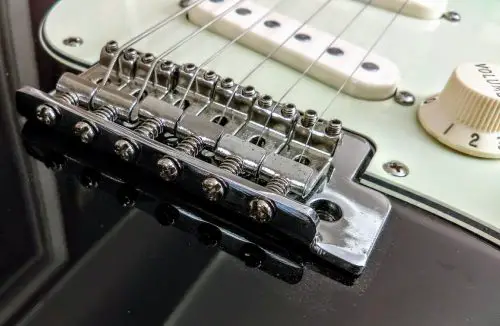
The bridge of a guitar plays a significant role in shaping the instrument’s tone.
The bridge of a guitar plays a significant role in shaping the instrument’s tone. It is responsible for transmitting the vibrations of the strings to the guitar body, which ultimately affects the sound produced. The design, material, and setup of the bridge can have a noticeable impact on the overall tone of the guitar.
One way in which the bridge affects tone is through its material. Different materials, such as brass, steel, or wood, can influence the resonance and sustain of the strings.
For example, a bridge made of brass may enhance sustain and add a warmer or more resonant tone to the guitar. On the other hand, a steel bridge might provide a brighter or more articulate tone. Wooden bridges can also contribute to the overall tone by adding warmth and depth to the sound.
The design of the bridge, including its shape and weight, can also impact the tone. A heavier bridge may absorb more vibrations from the strings, resulting in a more muted or rounded sound. Conversely, a lighter bridge may allow for more prominent string vibrations and a brighter or more focused tone.
Additionally, the way the bridge is attached to the guitar body can affect tone. A bridge that is securely and properly installed can optimize the transfer of vibrations to the body, resulting in a more resonant and balanced tone. On the other hand, a bridge that is not securely attached may dampen the vibrations, leading to a loss of sustain and overall tone quality.
Also Read: String Brand’s Impact on Tone: Unraveling the Secrets
Does the bridge affect the intonation of a guitar
The bridge of a guitar does affect the intonation. Intonation refers to the accuracy of the guitar’s notes across the fretboard. When the intonation is properly set, each note played on each string rings out in tune with the others. However, if the bridge is not set up correctly, it can result in the guitar being out of tune as you move up or down the fretboard.
The bridge plays a vital role in establishing the scale length of the guitar, which determines the placement of the frets and the distance between them. If the bridge is positioned too close to the nut, the scale length will be shorter, causing the strings to play sharp at higher frets. On the other hand, if the bridge is positioned too far from the nut, the scale length will be longer, causing the strings to play flat at higher frets.
Adjusting the intonation involves altering the position of the saddle on the bridge. The saddle is the part of the bridge that the strings rest on, and by moving it back or forth, you can change the effective length of the string. By carefully adjusting the saddle position for each string, you can ensure that the notes played at different positions on the fretboard are in tune with each other.
Also Read: 4 Factors That Affect Guitar Intonation: Tips For Best Tone
Different types of guitar bridges and their effects on tuning?
There are several different types of guitar bridges, each with its own characteristics and effects on tuning. The type of bridge a guitar has can significantly impact the instrument’s tuning stability, string action, sustain, and overall tone.
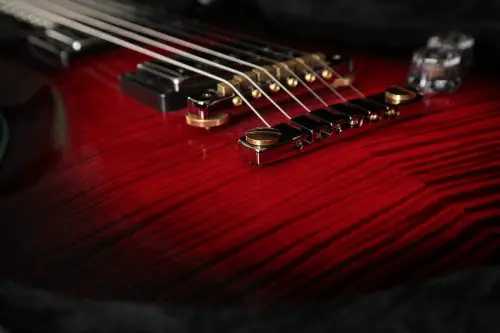
Fixed guitar bridge
1. Fixed Bridge: A fixed bridge, sometimes referred to as a hardtail bridge, is a non-movable bridge that is securely attached to the guitar body. It provides excellent tuning stability since there are no moving parts or potential points of friction. The strings are typically anchored through the body or a metal plate on the bridge. This type of bridge is commonly found on electric guitars, especially those designed for heavy music genres where sustain and stability are prioritized.
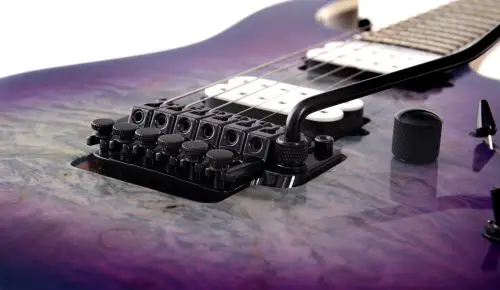
Floating bridge
2. Floating Bridge: A floating bridge, such as the archtop floating bridge or Bigsby vibrato, is commonly found on archtop and semi-hollow body guitars. This type of bridge is not fixed to the guitar body and is typically mounted on a wooden base. While floating bridges provide a unique tonal quality and the ability to manipulate pitch with a tremolo arm, they can require careful setup and maintenance to achieve optimal tuning stability.
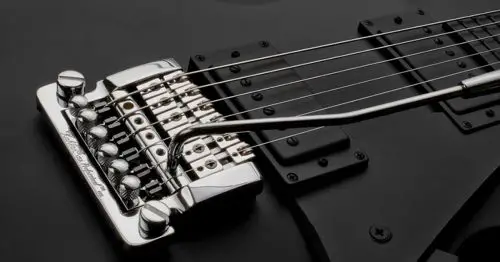
Tremolo bridge
3. Tremolo Bridge: A tremolo bridge, also known as a vibrato bridge, is a movable bridge that allows players to manipulate the pitch of notes by either pressing or pulling on a tremolo arm (whammy bar). Tremolo bridges include designs like the vintage-style synchronized tremolo, Floyd Rose system, or the floating tremolo.
While tremolo bridges offer expressive capabilities and the ability to create subtle pitch modulations, they can introduce challenges in maintaining tuning stability. The floating bridge types, in particular, can be more susceptible to tuning issues due to the balance between string tension and the tension of the springs in the back cavity of the guitar.
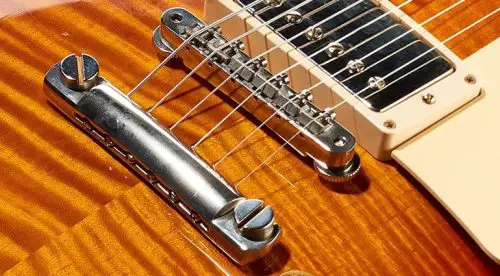
Tune o matic bridge
4. Tune-O-Matic Bridge: The Tune-O-Matic bridge is a popular type of bridge primarily found on electric guitars, especially Gibson-style guitars. It consists of individual adjustable saddles that allow for precise intonation adjustment for each string. While the Tune-O-Matic bridge provides good tuning stability and resonance, its floating design allows for fine-tuning adjustments by raising or lowering the bridge posts.
It’s important to note that the effects on tuning from different bridge types can also be influenced by factors such as the quality of materials, setup, and maintenance of the bridge. Regularly checking string intonation, ensuring proper string winding and tension, and keeping the bridge and its components in good condition can help maximize tuning stability regardless of the bridge type.
How do you set up a guitar bridge for optimal tuning stability?
Setting up a guitar bridge for optimal tuning stability involves several key steps. Here is a general guide on how to achieve this:
1. String Installation: Begin by installing fresh strings, ensuring that they are properly seated at the bridge and nut. Make sure the strings are evenly wound on the tuning pegs and that there are no kinks or excessive slack.
2. Adjust the Bridge Height: Start by adjusting the bridge height to achieve a comfortable string action. Use the appropriate hex key or screwdriver to raise or lower the bridge saddles evenly. A higher action can reduce the likelihood of buzzing or fretting out, which can contribute to tuning issues.
3. Intonation Adjustment: Check the intonation of each string by playing the 12th fret harmonic and comparing it to the fretted note at the 12th fret. If there is a noticeable difference in pitch, adjust the saddle position to achieve accurate intonation. Moving the saddle forward or backward will change the effective length of the string and bring the fretted note into tune.
4. Lubricate Contact Points: Apply a small amount of lubricant, such as graphite or specialized nut lube, to the contact points where the strings pass through the nut and the bridge saddles. This reduces friction and allows the strings to return to their original position after using the tremolo system or bending notes.
5. Check Spring Tension: For guitars with a floating bridge or tremolo system, ensure that the tension of the springs in the back cavity is balanced with the string tension. Adjust the spring tension by tightening or loosening the screws that secure the springs to the guitar body. This balance prevents excessive bridge movement and helps maintain tuning stability during tremolo or string bending.
6. Stretch and Retune: Stretch the strings by gently pulling and tugging on them while retuning. Repeat this process several times until the strings settle and hold their pitch more reliably.
Throughout the setup process, it is essential to make incremental adjustments and double-check the tuning after each step. Additionally, it may be beneficial to consult a professional guitar technician or utilize online resources for more detailed instructions based on the specific type of bridge and guitar model you have.
Summary
In conclusion, the guitar bridge plays a crucial role in both tuning stability and tone. Whether you have a fixed bridge for solid stability or a floating bridge for expressive possibilities, understanding how the bridge affects your instrument is key to optimizing your playing experience. Proper setup, including adjusting bridge height, intonation, and spring tension (if applicable), can greatly enhance tuning stability.
Remember, it’s not just about the bridge itself but also the materials, design, and maintenance. Experimentation with different bridge types, materials, and setups can help you find the perfect balance of tone and stability that suits your playing style.
So, the next time you’re tweaking your guitar’s bridge, take a moment to appreciate the impact it has on your tuning and the unique sound it brings to your fingertips. Whether you’re rocking out on a fixed bridge or diving into the depths of a floating tremolo, the bridge shapes your sound and keeps your strings in check, making every note you play ring true. Keep strumming, keep adjusting, and keep your tunes in harmony.
FAQ
How does a floating bridge affect guitar tuning stability?
A floating bridge can have both positive and negative effects on guitar tuning stability. A floating bridge, also known as a tremolo or vibrato bridge, is not fixed to the guitar body and can be manipulated to change the pitch of the strings. While it allows for expressive techniques like pitch bends and dive bombs, it can also introduce challenges in maintaining consistent tuning.
The floating bridge relies on a delicate balance between string tension and the tension provided by the springs in the back cavity of the guitar. When the bridge is adjusted for a specific string gauge and tuning, any change in tension, such as bending a string or using the tremolo bar, can affect the overall tuning of the instrument.
One common issue with floating bridges is the phenomenon called “bridge lift.” This occurs when the tension from string bends or tremolo use pulls the bridge forward, causing the strings to go sharp. Conversely, releasing tension can result in the bridge moving backward, causing the strings to go flat. These variations in bridge position can lead to constant adjusting and tuning.
To enhance tuning stability with a floating bridge, there are a few strategies you can employ. One is properly setting up the bridge and ensuring it is balanced with the tension of the springs in the back cavity. This involves adjusting the springs’ tension to counteract the pull from string bends or tremolo usage.
Another technique is to use locking tuners or a locking nut. These mechanisms stabilize the strings at the headstock, reducing the chances of slippage or loosening when using the tremolo or bending strings. Locking tuners eliminate the need for multiple windings around the tuning pegs, improving tuning stability.
Additionally, regularly lubricating the contact points of the bridge and nut, such as using graphite or specialized lubricants, can reduce friction and allow the strings to return to their original pitch more reliably.
What does raising the bridge on a guitar do?
Raising the bridge on a guitar can have several effects on the instrument’s playability and tone. One common reason for raising the bridge is to adjust the string action, which refers to the height of the strings above the frets. By raising the bridge, the strings are elevated, resulting in a higher action. This can have both positive and negative impacts.
Raising the bridge can increase the string action, making it easier to play chords and perform techniques like bends and vibratos. With higher action, there is more clearance between the strings and the frets, reducing the likelihood of unwanted buzzing or fretting out. This can be particularly beneficial for players who have a heavy hand or prefer a more aggressive playing style.
However, raising the bridge too high can also make the guitar more challenging to play. The increased distance between the strings and the frets requires more finger pressure to fret the notes, which can be tiring for the fingers and potentially hinder speed and fluidity in playing. It is essential to find a balance and set the bridge height to a level that allows for comfortable playability without sacrificing playability.
In addition to adjusting the string action, raising the bridge can also have an impact on the guitar’s tone. By raising the bridge, the angle at which the strings make contact with the bridge and the saddle can change. This alteration in the break angle can influence the overall string tension and the transfer of vibrations to the guitar body. As a result, raising the bridge may affect the sustain, brightness, or resonance of the instrument.
In my own experience, I have raised the bridge on a guitar to adjust the string action and improve playability. On one occasion, I found that lowering the bridge resulted in excessive buzzing and a lack of clarity in my playing. By raising the bridge slightly, I was able to eliminate the buzzing and achieve a more comfortable playing experience without sacrificing too much playability. Additionally, I have noticed that raising the bridge on certain guitars has resulted in a slightly brighter and more focused tone, which worked well for certain playing styles and genres.
Overall, raising the bridge on a guitar can be a useful adjustment for improving playability and tone. It allows for better control over the string action and can have subtle effects on the overall sound of the instrument. However, it is crucial to find the right balance and consider the trade-offs in playability and tonal characteristics when making adjustments to the bridge height. Experimentation and finding what works best for your playing style and preferences is key.





